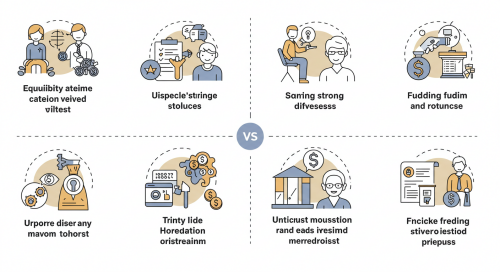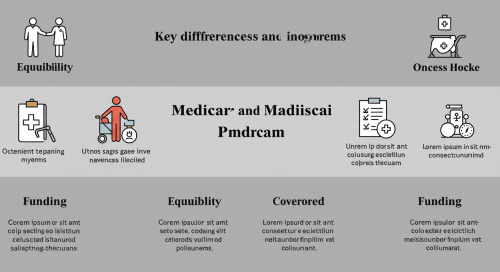Navigating the American healthcare system can be overwhelming, especially when it comes to understanding government-sponsored health insurance programs. Two of the most important programs are Medicare and Medicaid, which together provide health coverage for millions of Americans. Despite their similar names, these programs serve different populations, have distinct eligibility requirements, and offer varying levels of coverage. Understanding the key differences between Medicare and Medicaid is essential for anyone planning for their healthcare needs or helping family members access appropriate coverage.
What is Medicare?
Medicare is a federal health insurance program primarily designed for people aged 65 and older, regardless of their income level. Established in 1965 as part of the Social Security Act, Medicare also covers certain younger individuals with disabilities and people with end-stage renal disease or amyotrophic lateral sclerosis (ALS). The program is administered by the Centers for Medicare & Medicaid Services (CMS) and operates as an entitlement program, meaning that anyone who meets the eligibility criteria is entitled to receive benefits.
The fundamental principle behind Medicare is to provide basic health insurance coverage for older Americans who may face higher healthcare costs and potentially limited income during retirement. Unlike employer-sponsored health insurance, Medicare provides a safety net that continues regardless of employment status, ensuring that seniors have access to essential healthcare services.
Medicare is funded through a combination of payroll taxes, premiums paid by beneficiaries, and general federal revenues. Most people become eligible for Medicare at age 65, coinciding with traditional retirement age, though they can continue working and may have additional insurance coverage through their employer.

What is Medicaid?
Medicaid is a joint federal and state program that provides health coverage for low-income individuals and families. Unlike Medicare, which is primarily age-based, Medicaid eligibility is primarily determined by income and other factors such as disability status, pregnancy, or family composition. Each state administers its own Medicaid program within federal guidelines, leading to significant variations in coverage and eligibility requirements across different states.
The program was also established in 1965 alongside Medicare but serves a fundamentally different purpose. While Medicare addresses the healthcare needs of older Americans, Medicaid focuses on providing a healthcare safety net for those who cannot afford private insurance or who have limited financial resources. This includes children, pregnant women, parents, seniors, and people with disabilities who meet specific income requirements.
Medicaid is funded through a combination of federal and state funds, with the federal government matching state spending according to a formula that takes into account each state’s relative wealth. Wealthier states receive a smaller federal match, while poorer states receive a larger percentage of federal funding for their Medicaid programs.
Key Eligibility Differences
Medicare Eligibility Requirements
Medicare eligibility is primarily based on age and work history rather than income. To qualify for Medicare, individuals must be:
- 65 years of age or older and either a U.S. citizen or legal resident who has lived in the United States for at least five consecutive years
- Under 65 with certain disabilities and have received Social Security Disability Insurance (SSDI) benefits for at least 24 months
- Any age with end-stage renal disease requiring dialysis or a kidney transplant
- Any age with amyotrophic lateral sclerosis (ALS), with coverage beginning immediately upon SSDI eligibility
Most people don’t pay a premium for Medicare Part A (hospital insurance) if they or their spouse worked and paid Medicare taxes for at least 10 years. This work history requirement is crucial because Medicare is considered an earned benefit based on contributions made during working years.
Medicaid Eligibility Requirements
Medicaid eligibility is primarily income-based and varies significantly by state. The Affordable Care Act expanded Medicaid eligibility in participating states, but eligibility criteria still depend on several factors:
Income levels are typically measured as a percentage of the Federal Poverty Level (FPL). In expansion states, adults with incomes up to 138% of the FPL may qualify for Medicaid. In non-expansion states, eligibility requirements are often much more restrictive, sometimes limiting coverage to parents with incomes below 50% of the FPL.
Categorical eligibility requirements mean that in addition to meeting income requirements, applicants must fall into specific categories such as children, pregnant women, parents or caretaker relatives, seniors, or people with disabilities. Asset limits may also apply, though these vary by state and category.
Citizenship and residency requirements mandate that applicants must be U.S. citizens or qualified immigrants and residents of the state where they’re applying for coverage.
Coverage and Benefits Comparison
Medicare Coverage Structure
Medicare is divided into several parts, each covering different types of healthcare services:
Medicare Part A (Hospital Insurance) covers inpatient hospital stays, skilled nursing facility care, hospice care, and some home health services. Most beneficiaries don’t pay a monthly premium for Part A, but there are deductibles and coinsurance costs for services used.
Medicare Part B (Medical Insurance) covers doctor visits, outpatient care, medical supplies, and preventive services. Beneficiaries pay a monthly premium for Part B, along with an annual deductible and coinsurance for services.
Medicare Part C (Medicare Advantage) is an alternative way to receive Medicare benefits through private insurance plans approved by Medicare. These plans often include additional benefits like prescription drug coverage, dental, or vision care.
Medicare Part D (Prescription Drug Coverage) provides prescription drug coverage through private plans. Beneficiaries can add Part D to Original Medicare or choose a Medicare Advantage plan that includes drug coverage.
Medicaid Coverage Benefits
Medicaid provides comprehensive healthcare coverage that often exceeds what’s available through Medicare. Federal law requires state Medicaid programs to cover certain mandatory benefits:
Essential health services include inpatient and outpatient hospital services, physician services, laboratory and x-ray services, nursing facility services for adults, home health services, and family planning services. Additional mandatory benefits include early and periodic screening, diagnostic, and treatment services for children under 21.
Many states also provide optional benefits such as prescription drugs, dental care, vision care, physical therapy, occupational therapy, speech therapy, and personal care services. The scope of optional benefits varies significantly among states.
Long-term care services represent one of Medicaid’s most important features. Unlike Medicare, which provides only limited coverage for long-term care, Medicaid covers extended nursing home care and home and community-based services for eligible individuals.
Cost Differences and Financial Responsibility
Medicare Costs
Medicare beneficiaries typically face several types of out-of-pocket costs. Monthly premiums are required for Part B and Part D, with higher-income beneficiaries paying higher premiums through Income-Related Monthly Adjustment Amounts (IRMAA). Annual deductibles apply to both Part A and Part B services.
Coinsurance and copayments are required for most services, with beneficiaries typically paying 20% of the cost for Part B services after meeting the deductible. There’s no annual out-of-pocket maximum in Original Medicare, which can lead to significant costs for beneficiaries with extensive healthcare needs.
Many Medicare beneficiaries purchase supplemental insurance (Medigap) to help cover the gaps in Medicare coverage, including deductibles, coinsurance, and copayments. These supplemental plans require additional premium payments but can provide important financial protection.
Medicaid Costs
Medicaid generally has very low or no out-of-pocket costs for beneficiaries. Federal law limits cost-sharing for most Medicaid beneficiaries, with nominal copayments allowed for some services. Emergency services, family planning services, and pregnancy-related services cannot have any cost-sharing requirements.
For children and pregnant women, states cannot charge any premiums or cost-sharing. Adults may face small copayments for some services, but these are typically minimal amounts like $1 to $5 per service.
The low cost-sharing structure of Medicaid reflects its role as a safety net program designed to ensure that financial barriers don’t prevent access to necessary healthcare services for low-income individuals and families.
Dual Eligibility: When Medicare and Medicaid Work Together
Some individuals qualify for both Medicare and Medicaid, known as “dual eligibles” or “Medicare-Medicaid enrollees.” This typically includes seniors with limited income and resources, as well as younger people with disabilities who qualify for both programs.
For dual eligibles, Medicare typically serves as the primary insurance, covering hospital and medical services, while Medicaid provides supplemental coverage. Medicaid may pay for Medicare premiums, deductibles, and coinsurance, effectively eliminating most out-of-pocket costs for healthcare services.
Medicaid also covers services that Medicare doesn’t provide, most notably long-term care services. This coordination ensures that dual eligibles have comprehensive healthcare coverage without the financial burden that Medicare-only beneficiaries might face.
Special Needs Plans (SNPs) are Medicare Advantage plans specifically designed for dual eligibles, chronic condition sufferers, or institutional residents. These plans coordinate Medicare and Medicaid benefits and often provide additional services tailored to the specific needs of their enrollees.
Application Processes and Administration
Medicare Enrollment
Medicare enrollment is generally straightforward for most people. Those receiving Social Security benefits are automatically enrolled in Medicare Parts A and B when they turn 65. Others must actively enroll during specific enrollment periods.
The Initial Enrollment Period runs for seven months, beginning three months before turning 65, including the birth month, and ending three months after turning 65. Missing this period can result in late enrollment penalties for Part B and Part D coverage.
Annual Open Enrollment occurs from October 15 to December 7 each year, allowing beneficiaries to make changes to their Medicare coverage, including switching between Original Medicare and Medicare Advantage plans or changing prescription drug plans.
Medicaid Application
Medicaid applications are processed at the state level, though many states use the federal marketplace (HealthCare.gov) or state-based marketplaces for applications. The application process is more complex than Medicare enrollment because it requires verification of income, assets, household composition, and other eligibility factors.
Applications can typically be submitted online, by phone, by mail, or in person at local social services offices. States have varying processing times, but federal law requires decisions within 45 days for most applications and 90 days for disability determinations.
Medicaid eligibility must be renewed periodically, typically annually, requiring beneficiaries to verify continued eligibility by providing updated income and household information.
Geographic Variations and State Differences
Medicare Consistency
Medicare benefits and eligibility requirements are generally consistent across all states because it’s a federal program. However, some variations exist in Medicare Advantage plan availability and benefits, as these plans are offered by private insurance companies that may not operate in all geographic areas.
Medicare supplement insurance (Medigap) regulations also vary by state, with different states allowing different types of plans and having varying rules about when these plans can be purchased.
Medicaid State Variations
Medicaid programs vary significantly among states because states have considerable flexibility in designing their programs within federal guidelines. Key variations include:
Eligibility requirements can differ substantially, particularly for adults without children. Expansion states provide coverage to adults with incomes up to 138% of the FPL, while non-expansion states may have much lower income limits or may not cover adults without children at all.
Benefit packages vary among states, with some providing more comprehensive coverage than others. While all states must cover mandatory benefits, the scope and generosity of optional benefits differ significantly.
Provider networks and reimbursement rates vary by state, which can affect access to care and the quality of services available to Medicaid beneficiaries.
Planning for Healthcare Coverage
Medicare Planning Considerations
Individuals approaching Medicare eligibility should begin planning at least six months before turning 65. This includes understanding the different parts of Medicare, deciding whether to choose Original Medicare or Medicare Advantage, considering the need for prescription drug coverage, and evaluating whether supplemental insurance is necessary.
For those still working at 65, it’s important to understand how employer coverage coordinates with Medicare and whether it’s advantageous to delay Medicare enrollment while maintaining employer coverage.
Medicaid Planning Considerations
For individuals with limited income who may qualify for Medicaid, it’s important to understand the application process and required documentation. This is particularly important for seniors who may need long-term care services, as Medicaid planning can help protect assets while ensuring access to necessary care.
Families should also understand how changes in income or household composition might affect Medicaid eligibility and plan accordingly to maintain continuous coverage.

Future Outlook and Policy Considerations
Both Medicare and Medicaid face ongoing policy discussions about sustainability, coverage, and access. Medicare faces long-term financing challenges as the population ages and healthcare costs continue to rise. Policy proposals include various approaches to ensure the program’s long-term viability while maintaining benefits for current and future beneficiaries.
Medicaid policy discussions often focus on expansion in non-expansion states, work requirements, and the appropriate federal-state funding balance. These policy changes can significantly impact coverage and access for low-income Americans.
Understanding these programs’ current structure and potential future changes helps individuals and families make informed decisions about their healthcare coverage and financial planning. As healthcare costs continue to rise and the population ages, the importance of these safety net programs in providing healthcare security for millions of Americans cannot be overstated.
The distinction between Medicare and Medicaid extends far beyond their similar names. While Medicare provides healthcare security for older Americans and certain disabled individuals regardless of income, Medicaid serves as a crucial safety net for low-income individuals and families of all ages. Together, these programs form the backbone of America’s healthcare safety net, ensuring that the most vulnerable populations have access to essential healthcare services. Understanding how these programs work, who they serve, and how they can work together is essential for navigating the complex American healthcare system and planning for future healthcare needs.

Hi, I’m Hibiki — the writer behind HealthManual.net.
I cover health insurance news, wellness tips, and insightful analysis of pharmaceutical and healthcare stocks. My goal is to simplify complex topics and make health and finance information more accessible to everyone.
Thanks for reading — I hope you find the content helpful and reliable.















